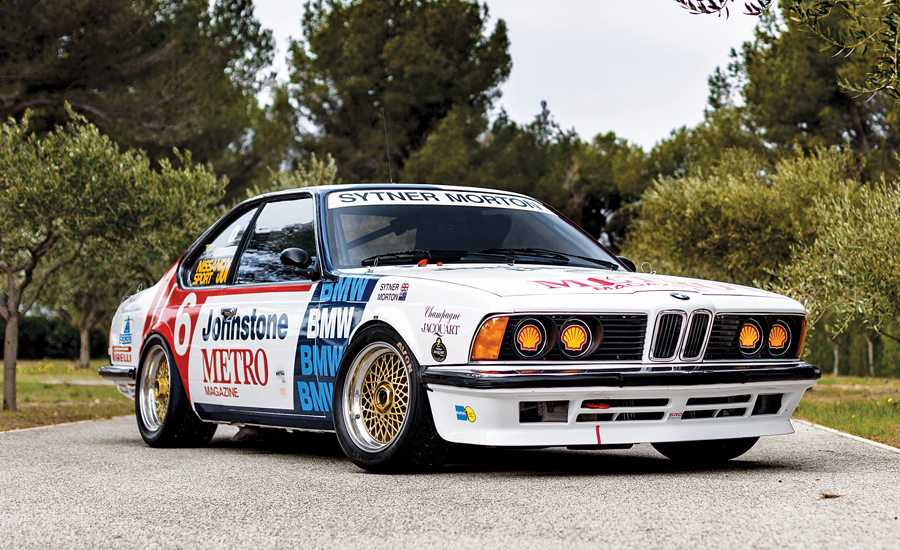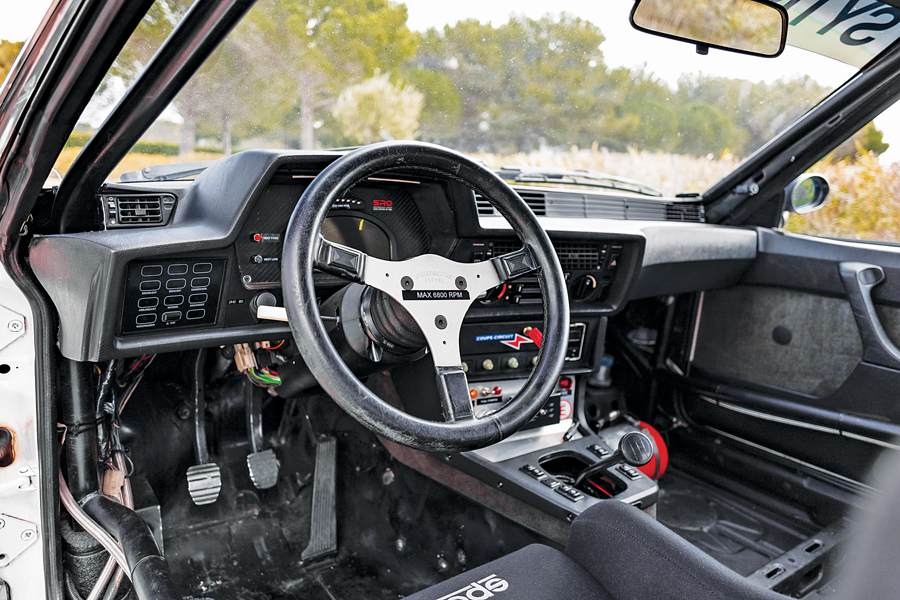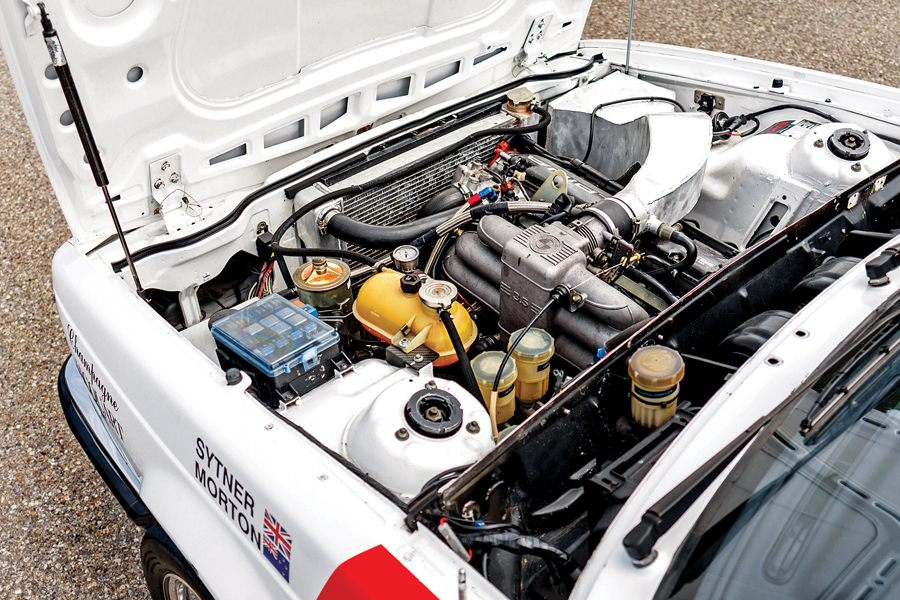- Constructed in 1982/1983 by BMW specialists Ted Grace International for Frank Sytner
- Competed in BTCC/ETCC in 1983 and 1984, driven by Frank Sytner, Brian Muir and Barrie Williams
- Extensive British and New Zealand racing history
- Immaculately prepared and eligible for a wide range of 1980s and Group A touring car events
SCM Analysis
Detailing
| Vehicle: | 1983 BMW 635 CSi Group A |
| Years Produced: | 1983 |
| Number Produced: | 90 (“white” motorsports chassis) |
| Original List Price: | N/A |
| SCM Valuation: | $263,525 |
| Chassis Number Location: | Stamped just outside of the right strut tower in the engine compartment |
| Engine Number Location: | Boss above starter |
| Club Info: | BMW Car Club of America |
| Website: | http://bmwcca.org |
| Alternatives: | 1983 Ford Capri III 3.0, 1983 Rover Vitesse 3.5, 1983 Jaguar XJS racer |
| Investment Grade: | B |
This car, Lot 183, sold for $355,037, including buyer’s premium, at RM Sotheby’s sale in Monte Carlo, MCO, on May 12, 2018.
As virtually all readers of this magazine are aware, the market for collector/racing cars has been a bit challenging for the past few years.
It hasn’t really been bad — most cars are still finding new homes — but the inflating-market glory days of the early 2000s are well behind us. Values for non-crown-jewel Porsches and Ferraris have been stagnant to drifting downward by 2% to 3% per year.
Less-desirable marques have not been so lucky. There are exceptions, though: Over the past five or more years BMW racers have steadily grown in visibility and value. Not only that, but the trend looks likely to continue for a while to come.
How is BMW bucking the trend? Hopefully, I can provide some insight.
German rivalries
Most people (and certainly Americans), when queried about German racing traditions, will immediately point to either Porsche or Mercedes-Benz as the exemplars, but that is an incomplete picture.
One of the great internal rivalries within Germany is between the Swabians around Stuttgart (Porsche, Mercedes) and the Bavarians from around Munich (BMW); both sides think they build the best cars.
Mercedes more or less invented the automobile, while BMW started building cars in the 1920s, and Porsche didn’t come along until just after World War II, but they all at various times have come to see racing and winning as essential to their identities.
BMW goes racing
Starting in the mid-1930s, BMW saw itself as a manufacturer of high-quality, upmarket sporting automobiles. BMW enjoyed considerable success with its 328 series of 2-liter cars.
The engine was a light and innovative 2-liter 6 with a somewhat unique cam-drive system that allowed a hemispherical combustion chamber and excellent porting without the expense or complication of twin overhead cams.
The car was introduced to the racetrack in 1936, and it was very successful before World War II, winning its class at the 1938 Mille Miglia and the 1939 Le Mans, and taking an overall win at the 1940 Mille Miglia — along with scores of other victories.
The engine was so good that the design and tooling were taken as reparations after the war and given to Bristol in England, where it powered many sports cars such as the AC Bristol and was the go-to 2-liter racing engine almost into the 1960s.
Recovery from the wreckage of World War II was very hard for BMW, and a series of questionable strategic decisions to build expensive, niche-market cars such as the 503 and 507, for which there just wasn’t a market, made recovery even more difficult.
So racing was reluctantly abandoned.
The comeback
BMW did obtain a license to build an Italian-designed bubble car called the Isetta which sold extremely well, and they got motorcycle production going again, so by the late 1950s BMW was doing well enough to venture back into normal automobile production.
Having learned their lessons about overestimating the market, BMW chose to concentrate on relatively light, high-quality sporting sedans. By the mid-1960s, BMW was one of Germany’s premier manufacturers. With financial success came a return of competitive urges, and BMW re-entered the fray in 1965 with the 1800TiSA, a homologation special that gave tuners Alpina and Schnitzer a good core to build sedan racers around.
In the mid-1960s, BMW made the decision to introduce a lighter, simpler version of their 1600 sedan, to be called the 1602 (for 2-door), and it sold well.
Several BMW directors independently chose to install 2-liter versions of the engine in their personal 1602s and loved the result, so they persuaded management to offer the big motor and call it the BMW 2002. Much after that is known history. In 1968, BMW introduced what is known as the “big six” series of cars, with the engine being literally a 6-cylinder version of the original 4-cylinder engine, and it was 3 liters vs. 2 liters.
In 1965 the 2002 was selling so well that BMW decided to introduce a proper 2+2 coupe version — to be called the 2000 CS, and the logical progression soon had the 6-cylinder engine dropped into it to create the 2800 (later 3.0) CS coupe.
For years, privateers had been terrorizing European saloon racing with their 2002 sedans. Now BMW had something to contest the 3-liter “Big Car” class.
Through the 1970s and 1980s, BMW had a great degree of success with variants on the CS coupe, running from 2.8 up to 3.5 liters, culminating with the iconic “Batmobile” CSLs that ran at the front of the pack in the FIA premier events.
Unfortunately, that was about the time that Porsche finally got their turbocharged 935s fully up to speed and BMW had already stopped production of the old CS, so they had little reason to continue. They exited the FIA championship wars and let hot rod tuner affiliates concentrate on smaller series like the touring car championships.
Enter Group A
In 1982, a new set of rules was in place for what was to be called “Group A” FIA racing, the category that both British and European Touring Car Championships used.
It required “minimum production of 5,000 cars per year and a back seat, and the wheels more or less had to fit inside the original bodywork.
Engine modifications were limited, but transmissions and brakes were free, and the suspension could be modified a little bit. The general idea was to provide excellent racing in cars that the spectators could reasonably expect to be like the ones they drove daily, which gave a basis for marque loyalty.
The series was very popular with spectators and paid well enough to be worth chasing after wins. More to the point, the new rules fit BMW’s 3.5 CSi very well. The British championship limited displacement to 3.5 liters, while the European one used weight and other limitations to allow a level playing field, so the CSi had every reason to be competitive.
Our subject car
Although the factory had given up preparing racing cars itself, it was happy to supply “white” motorsport chassis (basically stripped cores to build from) to competent preparation shops, which is how our subject car came into existence.
Ted Grace built the car in the U.K. for Frank Sytner to drive, primarily in the BTCC series, with occasional forays into the ETCC.
The car did very well over the 1983 and 1984 seasons in Europe. It then was taken to New Zealand to race for a few years before getting put away. It returned to Europe in 2016, and acquaintances who inspected it pronounced it as being a “lovely old original car.”
A car for the track
Let’s be clear. Unless you are a very hard-core BMW collector, there is no reason to buy this except to go play with it.
The collector value is minimal, so a car like this is purchased for a specific purpose — the joy and the experience of racing.
In Europe, Patrick Peter runs an excellent Heritage Touring Cup series that provides lots of track time and competition, so in Europe, racing is available. There are fewer events in the United States.
In terms of the experience, by all accounts all the BMW CS variants are sweet, easy cars to drive. They are highly dependable and relatively cheap to maintain. A terminally blown-up engine replacement is maybe $20,000 — try that in your Porsche.
Finally getting notice
So what is happening with value? Why are these cars still going up? I will argue that it is a function of exposure.
For better or worse, Americans drive most of the market in racers like this, and most Americans have been obsessed with Porsches and Ferraris. For most of the 1970s and 1980s in the U.S., BMW was selling luxury cars — not competing in races — with the result that few racing folks have taken them seriously.
BMW’s very formidable racing cars have been underrated for far too long, but this is changing. The market has only taken off in the past five to seven years, and it is still well behind equivalent Porsche values.
What’s not to like? This CSi is German, very pretty, fast, dependable, a joy to drive, relatively cheap to maintain — and very safe should things go wrong.
A number of private sales confirm the price to be within the expected range, and the general trend is still upwards. I would say well bought. ♦
(Introductory description courtesy of RM Sotheby’s.)


